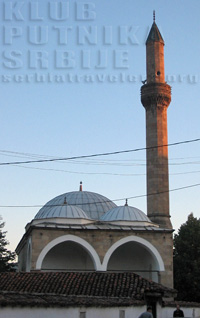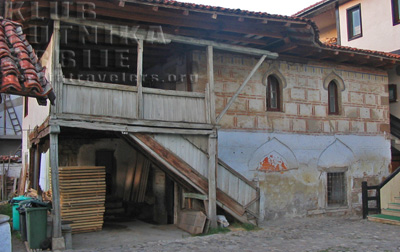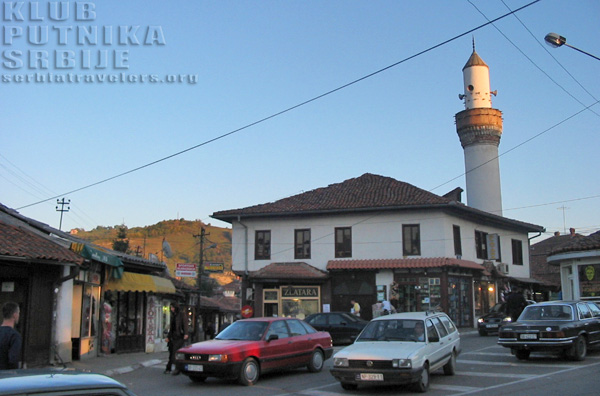Novi Pazar
 Novi Pazar is a city in southwestern Serbia, the administrative centre of the area known as Sandzak. The city has 85.000 inhabitants, 80% of them belonging to the Muslim confession.
Novi Pazar is a city in southwestern Serbia, the administrative centre of the area known as Sandzak. The city has 85.000 inhabitants, 80% of them belonging to the Muslim confession.
Narrow Ottoman-style alleyways, small shops with their owners sitting in the street all day long observing passersby, old-fashioned houses with wooden terraces, a small fortress in the city centre and numerous mosques give the city a special, oriental air.
Novi Pazar boasts the oldest religious monument in these parts. It is the Peter’s Church, where the important Serbian saint, St. Sava, was christened.
On a hill overlooking the town severely damaged Djurdjevi Stupovi Monastery can be seen. The hill offers breathtaking views of the surrounding villages and mountains.
A visit to Novi Pazar certainly isn’t complete without visiting some of the small inexpensive restaurants scattered all around the city centre.
History of Novi Pazar
In the 12th century, the Raska River Valley was the founding place of the first independent Serbian state, with the old city of Ras as its capital. The ruins of this city can still be seen near Novi Pazar. The founder of this state was Stefan Nemanja, who built Djurdjevi Stupovi Monastery in what’s today Novi Pazar. Peter’s Church stands witness that this area was inhabited even before that – the oldest preserved part of the church (a stone “baptiserium” – a christening pool) dates from the 7th century.
The city of Novi Pazar was founded in 1459, at the confluence of the Josanica and Raska rivers. Its founder was Turkish army commander Ishak-beg Ishakovic. The town was located at the junction of important roads connecting Dubrovnik, Bosnia and the sea coast with Istanbul and Salonika. At the time of its founding, Novi Pazar was mostly inhabited by craftsmen and merchants, whose shops were in the city centre – exactly where they are today. 
The most important monuments of Islamic architecture date from the period just after the founding of the city. Isa-Beg’s Mosque was built in 1460, and Altun-Altem Mosque in 1525.
In April 1809, in the First Serbian Uprising, Novi Pazar was temporarily conquered by Karadjordje, but he didn’t manage to penetrate the fortress in the city centre.
The city was finally liberated from the Turks in 1912, and from the Austro-Hungarians in 1918. During the Second World War, the city was occupied by the Germans and severely devastated. It was finally liberated in 1944.
{tab=getting there}
Getting to Novi Pazar
Novi Pazar is easy to reach by bus from any of the neighboring towns. There are 10 daily buses connecting Novi Pazar with Belgrade, one with Skopje, Podgorica, Pristina, Sjenica and Novi Sad and 4 with Rozaje.
Novi Pazar is not on the railway. If you’re into trains, the closest nearby city reachable by train is Raska, from where you can take a bus to Novi Pazar (there are 8 daily buses connecting the two cities).
Train from Belgrade leaves for Raska every day at 06.10 and 12.04 am, and arrives at 03.15 and 09.10 pm.
{tab=things to see}
What to see in Novi Pazar?
Old city centre consists of a couple of picturesque streets with somewhat exotic Ottoman air. Houses are mostly small, old-fashioned, hosting numerous craftmen’s and merchants’ shops. City core isn’t big and can be thoroughly surveyed on a slow half hour’s walk. One of the oldest and most interesting structures is Amir-Aga’s Han.
Altun-Alem Mosque (Turkish for “mosque with the precious stones”) can be seen in the old city centre. It was built by the Ottoman architect Abdul Gani, in the first half of the 16th century. The building technique involved the alternate usage of trimmed and broken stone, with layers of bricks. In the mosque courtyard there is an auxilliary building in typical Ottoman architectural style, with wooden stairs and a balcony. The mosque has one minaret and the roof is covered with domes, which makes it different from most other mosques in this region.
The old Turkish Bath, “hamam”, can also be seen in the city centre. It was built by the city founder, Isa-Beg Isakovic, in mid 15h century. It is a rare example of a mixed gender bathroom. 
On a hill, just out of the city, is the Peter’s Church (Petrova crkva) built in 7th century in place of an old Illyric temple. The church has been damaged and restored many times, and only a small part survived up to this day. It is the early Christian baptiserium, a small christening pool, which can be seen today. Church also has frescoes from 10th, 12th and 13th century. The building is locked, and the key is with the old lady living in a little house just by the graveyard surrounding the church.
Djurdjevi Stupovi Monastery, dedicated to St. George, is located on top of a hill, just above the city. It was built by Stefan Nemanja in 1171, according to the inscription on the church’s west portal. The church was decorated in 1175. King Dragutin later added a chapel and painted the parvis. He also converted the entrance tower into a chapel. Monastery got deserted during the Turkish reign, in 1689, and was severely damaged in the Second World War. The restauration process has started in the last decade of the 29th century, with the building of a dormitory and founding of the monastic brotherhood.
In the very centre of the town, surrounded by a park, there’s an old fortress. It was built by the Ottoman Turks in the 15th century, and new parts were added in 17th and 19th century, including two towers, storehouse, barracks and a little mosque inside the fortified complex.
The tower known as “Stara izvidnica” (Old Watchtower) is located next to the northern wall.
{/tabs}

